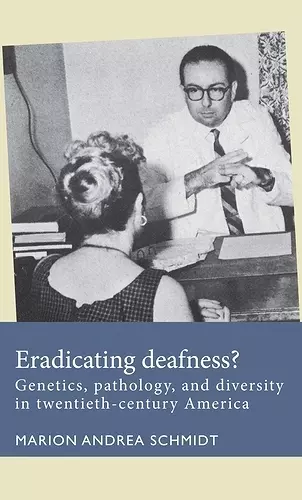Eradicating Deafness?
Genetics, Pathology, and Diversity in Twentieth-Century America
Format:Hardback
Publisher:Manchester University Press
Published:22nd Apr '20
Currently unavailable, and unfortunately no date known when it will be back

Is deafness a disability to be prevented or the uniting trait of a cultural community to be preserved? Combining the history of eugenics and genetics with deaf and disability history, this book traces how American heredity researchers moved from trying to eradicate deafness to embracing it as a valuable cultural diversity. It looks at how deafness came to be seen as a hereditary phenomenon at all, how eugenics became part of progressive reform at schools for the deaf, and how, from the 1950s on, more sociocultural approaches to disability and minority led to new cooperative projects between professionals and local signing deaf communities. Analysing the transformative effects of exchange between researchers and objects of research, this book offers new insight to changing ideas about medical ethics, reproductive rights, the meaning of scientific progress and cultural diversity.
'Schmidt (Univ. of Göttingen Medical Center) documents the historical attempts to eradicate deafness genes through coercive and restrictive measures including marriage counseling and family planning practices in order to achieve "normalization," as well as the 20th-century embrace of biodiversity and of being Deaf as a situation entailing cultural/linguistic differences. In 1977 this reviewer sat in McCay Vernon’s psychology class alongside Deaf classmates, whom he asked to reflect on their etiologies and family histories. Vernon’s respect for Deaf culture and sign language informed his research in genetics and his genetic counseling practice, which aimed to provide self-knowledge as well as psychological and emotional support. Vernon's work, among others cited in this book, led the historic shift in perceptions, paradigms, and terminology about being Deaf, redirecting genetics research and genetic counseling. Prior to this shift, perceptions about genetics and deafness followed a pathological/curative paradigm. But the new sociocultural perspective surfaced and embraced both signing as a cultural practice and population diversity as a norm. Previously used terms, e.g., "risks" have now shifted to "chances," reducing the blame and stigma of this "disability." Genetic counseling now supports the client in deciding which services to use, which decision to take, and what is considered a pathological condition, along with providing access to appropriate information.'
--J. F. Andrews, emerita, Lamar University
Summing Up: Recommended. Graduate students, faculty, and professionals.
Reprinted with permission from Choice Reviews. All rights reserved. Copyright by the American Library Association.
'[...] this valuable work stands out in its nuanced exploration of the in-between places.'
Social History of Medicine
'A masterful study of the history of genetic deafness research, Eradicating Deafness? exemplifies how new historical perspectives can be developed by merging disability history with the history of science.'
European Journal for the History of Medicine and Health
'In this valuable addition to Manchester University Press’s fast-growing Disability History series, Marion Andrea Schmidt chronicles a history of the intersection of eugenics, genetics, Deafness, and disability throughout the United States in the twentieth century. [...] Eradicating Deafness? offers important contributions beyond its immediate scope in the history of medicine. While Schmidt is right to continuously emphasize the narrative’s often surprising conclusions, the book’s other achievements—its clear style, minute attention to archival detail, and adept synthesis of seemingly disparate fields of inquiry—will also contribute to broader studies of history, politics, and culture.'
Bulletin of the History of Medicine
'Overall, this is a fascinating work that creatively connects case studies that, through another lens, may seem disjointed. It serves as both an important work in its own right and a springboard for potential new and exciting endeavors.'
H-Disability
'Overall, this is a fascinating work that creatively connects case studies that, through another lens, may seem disjointed. It serves as both an important work in its own right and a springboard for potential new and exciting endeavors.'
Bulletin of the History of Medicine
ISBN: 9781526138170
Dimensions: 216mm x 138mm x 14mm
Weight: 399g
216 pages